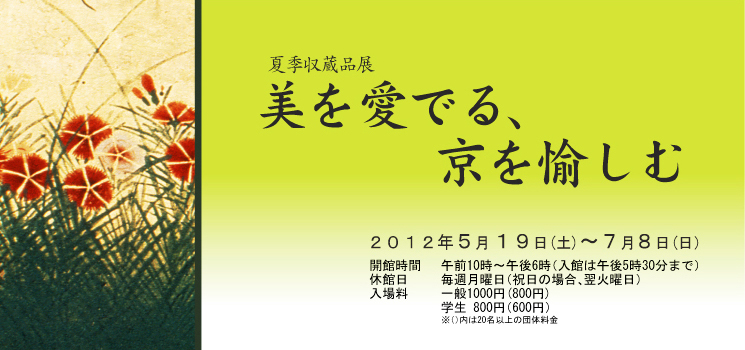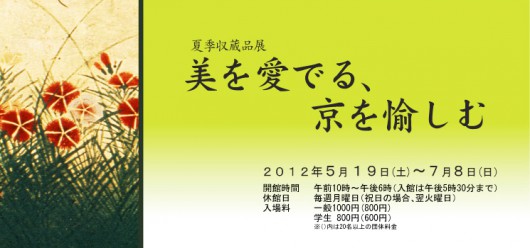Event
Appreciating Elegance and Enjoying Kyoto
May 19, 2012 (sat) – July 8, 2012 (sun)
Admission: Adults:1000yen(800)
Students: 800yen(600)
* Prices shown in ( ) indicate group (more than 20 persons) discount tickets.
http://www.emuseum.or.jp/eng/exhibition_eng/index.html
Venue
Hosomi Museum
http://www.emuseum.or.jp/eng/index.html
Access: 6-3 Saishoji-cho Okazaki, Sakyo-ku, Kyoto, Japan
Tel: 075-752-5555
Hours: 10:00 ~ 18:00
(entry up to 30 minutes before closing.)
Closed: Monday
(Tuesday if the Monday is a national holiday)
Description
Sakai Hoitsu (1761-1828) was born in Edo as the second son of Sakai Uta-no-kami, a feudal lord and high-ranking official in the Tokugawa shogunate. In accordance with the Sakai clan tradition of valuing the arts, Hoitsu enjoyed such pastimes as writing poetry, painting and doing calligraphy from a young age, and after dabbling in satirical poetry, ukiyo-e, and other examples of the popular culture of Edo in his twenties, Hoitsu became a Buddhist priest at the age of 38, which gave him even greater artistic freedom. From around this time he became an ardent admirer of the Rimpa school of Japanese painting that had been founded in Kyoto by Hon’ami Koetsu and Tawaraya Sotatsu, eventually going on to establish the style that is today referred to as “Edo Rimpa” by incorporating into the Rimpa school the latest trends and a level of sophistication that were the hallmarks of the late-Edo period. While at his strongest in producing elegant and refined paintings of flowers and birds, Hoitsu had a flexibility that enabled him to deal with a range of subject matter and styles, including genre paintings, Buddhist paintings, auspicious paintings, and ink paintings done in a witty and simple haiku-like style, creating his own unique world of painting while maintaining ties with a great many culturati.
The Edo Rimpa school remained in existence for over a century after the death of Hoitsu, and the activities in the closing days of the Tokugawa shogunate of artists such as Hoitsu’s most able pupil, Suzuki Kiitsu (1796-1858), and Ikeda Koson (1801-1866) have attracted a great deal of attention in recent years.
This volume was compiled as the catalog for the exhibition Celebrating the 250th Anniversary of Sakai Hoitsu’s Birth Sakai Hoitsu and the Edo Rimpa School, held to mark the 250th anniversary of Hoitsu’s birth. One of the largest on this subject to date, this exhibition includes Hoitsu’s most famous work, the pair of two-fold screens Summer and Autumn Grasses (Important Cultural Property), along with numerous other fine works by Hoitsu as well as various works considered beyond the scope of earlier “Rimpa” exhibitions and countless recently discovered materials, serving as a retrospective of Hoitsu and also shining a light on the individual achievements of his successors. Although some of the works can only be seen alongside each other in the pages of this volume, the book also gives readers the opportunity to experience the exhibition vicariously, offering an insight into the life of Sakai Hoitsu and the history of the Edo Rimpa school, whose aesthetic remains alive in the form of an undercurrent that flows beneath the surface of modern and contemporary Japanese society.
We would like to express our gratitude the owners of collections who showed remarkable understanding and support amidst the confusion that followed the 11 March earthquake and tsunami and consented to the exhibition of their precious artworks, as well as all the other parties who cooperated in this endeavor.






